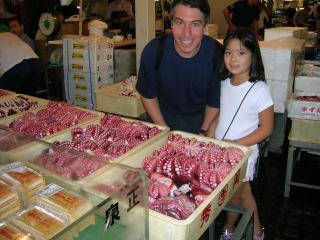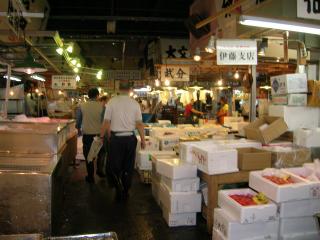Japan: Kyoto and Nara--Bambi 2, Dylan 0
Although Kyoto is highly recommended on the tourist track in Japan, I was a bit worried it was way overhyped and we wouldn't enjoy it as much as we enjoyed Tokyo. (Overhyped like the Grand Canyon, the Lincoln Monument or Alcatraz, which end up being really cool places). I was wrong. Kyoto is where you will see old Japan, such as the images from James Clavell's Shogun, in cosy co-habitation with modern Japan-like Tokyo. A few facts about Kyoto I didn't know before going there. One is that it's about the size of the greater Portland area, which means that it has a bit of a cosmopolitan flair (our friends from the east coast are laughing) but it isn't so crowded that every encounter in public is a physical jockying for space. Second, it avoided being bombed during World War II. That means that most of the architecture that was created during the pre-Meiji period still stands. Third, it was the capital of Japan until as recently as 1886 so it was the home of a lot of movers and shakers.
We visited a few temples, shopped in a open air market, where I scored a 50-100 year old obi (the sash used by women while wearing their kimonos) for $10 and found ourselves, after eating a really yummy Indian meal, in Gion. Gion is an area of Kyoto that has some of the oldest buildings. Many of these buildings house restaurants and private clubs, and a constant stream of taxis droppingoff business men was evidence that this is a happening spot. Shortly before entering the streets of Gion I explained to Dylan that we might see a Geisha, a traditional Japanese hostess who is dressed in an elaborate kimono and has her hair and face exquisitely made up. As we were coming out of a shop Dylan spotted three Geishas coming towards us. It was like seeing an incredibly rare bird and the late Princess Diana rolled into one, given the excitement and cameras flashing upon seeing one. It's not like they are hanging out for the tourists (or at least tourists like us who are not willing or able to shell out $300 or more a night for their company) so they scurry to their apointments, trying to avoid as many of the tourist camera wielding papparazzi as they can. All in all we saw about nine Geishas and were blown away by their exotic looks as well as the idea that in 2005 we are seeing a bit of Japanese culture that has been around for centuries, still thriving. (Actually our bible, the Lonely Planet, says that there are fewer and fewer Geishas or maiko (geishas in training). I'm not sure to what extent they are thriving.)

After spending just a couple days in Kyoto, we barely scratched the surface of what is offered. By the way, there are so many temples/shrines there that you are kind of tripping over them on the way to Starbucks. (Yes Virginia, there is a McStarbucks all over the world, even in China's Forbidden City) We took a short 40 minute train ride out to Nara to see the Todai-ji temple with one of the largest Buddhas in the world. Dylan is a huge fan of the Todai restaurant in town, and so her ears perked up when she heard we were going to a Todai temple, she could only imagine the acres of sushi offered at a temple devoted to the restaurant, but we had to break the news to her that the temple came before the restaurant. The Todai-ji temple is the largest wooden structure in the world. Its scale is immense and I told Dylan the next time she comes across something this large it will probably be the Forbidden City in China or the Taj Mahal in India. This temple holds the Daibutsen, one of the largest bronze statutes of a buddha. This buddha was about as big as the one we saw in Kamakura on a previous trip to Japan. The temple cost us $13 to enter and we agreed that this was the best value of temple to cost we've seen.


We couldn't get to the temple without first dealing with the 1200 deer that roam freely around the park, accosting terrified children for handouts. Vendors sell round biscuits for 150 yen that you can feed to the deer, so they've been rendered huge mooches. Apparantly in pre-buddhist times deer were seen as messengers from the gods, so these deer are descendants of a long line of nationally protected deer. It was all fun and games for Dylan, feeding and petting the deer, until we got into a herd of aggressive guys with "huge" racks and one of them scratched her on the leg, then she screamed, cried and swore she hated all deer except the "Bambis"--tiny ones with no horns.


A mention must be made of where we are staying tonight. We are in a traditional Japanese inn called a ryokan. A ryokan can range from $40-1000 a night per person. The rooms have a tatami mat covering, and futons are laid out on the floors, covered with thick comforters. Many ryokans have rooms with private toilets, but almost all have a public bath. You sit on a stool and shower yourself off with a hose (this is where the cleaning gets done), and then jump into a deep bath filled with hot water. It's really a delight. After donning our yakuta (simple cotton kimono) we were directed into another tatami matted room where our dinner waited for us. We had ordered ahead, when we made our reservations, for a traditional Japanese meal and it was divine, a true splurge among many on this trip. We are staying at the Ryokan Matusma which is a clean, comfortable place. The business has been in the family for over 25 years and the son, who worked at the Westin in Chicago was our chef for the evening. He and his wife were very friendly and made our stay very enjoyable.

From experiencing the sublime, we are now going to the most sobering. We leave today from Nara, via Kyoto to Hiroshima, where we spend a few days before heading south to our ferry.







